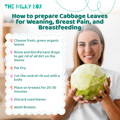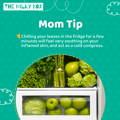Warm or cold compresses are great for relieving pain and discomfort. They’re super easy to make at home. You need a very soft washcloth that you can dampen with warm water (never hot as this will further irritate the skin). For Cold compresses, dampen them directly from the sink and cool them down in the freezer for a couple of minutes before applying. The relief will be instant!
How to use Cabbage Leaves for Weaning and Alleviating Breast Discomfort
By: Dr. Maria Cerino - Updated April 12, 2024 - 7 Minute Read

For many moms, breastfeeding is a magical experience. It’s a moment of bonding, nourishment, and feeling connected to your baby. However, not a lot is said about the challenges that moms can face during this process.
Breast Pain, mastitis, Infections, and difficulty weaning are some of the most common breastfeeding problems that moms experience.
In this article, we’re here to tell you that you’re not alone. It’s extremely common, and there are multiple ways to help your body get rid of the pain and inflammation.
Table of Contents:
1. Engorgement in Breastfeeding Moms
2. Mastitis in Breastfeeding Moms
3. Cabbage Leaves for Mastitis Pain While Breastfeeding
4. Protecting Your Milk Supply
6. How to Use Cabbage Leaves for Weaning, Breast Pain and Breastfeeding
7. Do Cabbage Leaves Dry Up Breast Milk?
8. Are Cabbage Leaves Good for Breastfeeding Mothers?
Engorgement in Breastfeeding Moms
Breast engorgement is a process that the body experiences as milk production increases with your baby’s arrival. The more they eat, the more your body produces.
It happens as your body shifts from the first stage of lactation (which starts during pregnancy) to the second stage. The second stage begins just a few days after delivery, and it’s when your milk starts “coming in.”
Your body gets you ready for breastfeeding by sending more blood and lymph to your breasts, too. This results in a level of fullness in the breast tissue that becomes painful for the patient. This also makes latching difficult for the baby, and for some moms, breastfeeding becomes excruciating.
Signs that you’re suffering from breast engorgement:
● Swelling of both breasts, especially in the lower areas (farthest from your chest).
● Pain in your breasts, sometimes severe.
● Breasts that feel firm or hard.
● Less commonly, sweating, fever, and chills.

Mastitis in Breastfeeding Moms
You can think of mastitis as engorgement’s less friendly sister. Mastitis is also an inflammation of the breast, but this time, it can include bacterial infection. It, more often than not, includes fever and chills.
The risk of mastitis can be reduced by frequent, complete emptying of the breast and by optimizing breastfeeding techniques. It is extremely uncomfortable but easily resolved with anti-inflammatory medication, cold compresses, and antibiotics.

Cabbage Leaves for Mastitis Pain While Breastfeeding
While many of us don’t reach for coleslaw first at the barbecue, there are many benefits to cabbage. It isn’t big on the Western diet, but it is the typical green veggie we often cover in dressing to make it more palatable.
However, for decades, there has been a well-kept secret among many moms out there: Cabbage leaves can relieve your breast pain and allow you to breastfeed without feeling terrible. It acts as a cold compress but has also been proven to contain anti-inflammatory properties.
Protecting Your Milk Supply
Lactation mastitis is a condition that can make you feel exhausted and worn out, making it challenging to take care of your baby. In some cases, mastitis may even cause a mother to stop breastfeeding before she intends to.
However, it is recommended that you continue to breastfeed even while taking antibiotics to treat mastitis, as it is better for both you and your baby. For those who find it challenging to manage the pain, supplementing with baby formula may be a viable option to get through this difficult period.
Take a look at our guide for combining baby formula and breast milk to optimize your baby's nutrition while learning how to preserve your milk supply while healing.
The Best Breast Milk Complement
We recommend using European baby formula to protect your baby's health and ensure a consistent milk supply. Its nutritional composition closely mimics mother's milk, and it tastes and textures like breast milk.

What Does the Science Say?
The effectiveness of cabbage leaves in reducing breast discomfort has been studied for many years. A study in 2017 found that mothers who used cabbage leaves and gel packs had significant symptom reduction, particularly in the hardness of breasts, one or two hours after the first application.
A 2012 review compared multiple studies done in previous years regarding cabbage’s efficiency on mastitis and breast engorgement found similar results, hardness being the most alleviated symptom. While there is evidence to show for improving symptoms, we must remember to consult a qualified provider, particularly when signs of infection arise. However, it is a safe method to try at home, and many mothers have benefited from it for decades.
How to Use Cabbage Leaves for Weaning, Breast Pain and Breastfeeding
Now here’s the biggest question of them all: how do I prepare my cabbage leaves? Do not fret! If you’re looking for an at-home fix while you wait on your doctor’s appointment, you can follow these steps to prepare them at home:
● Start at the supermarket: Choose fresh, green organic leaves
● Rinse off the leaves at the sink to remove all dirt and pat dry. Some women use disinfectant drops to make sure their leaves are thoroughly clean.
● Cut the central rib out with a knife; this will allow the leaves to adapt to your breast shape
● Leave it on your breasts for 20-30 minutes
● Discard used leaves. You will notice wilting after use
● Wash the skin on your breasts with warm water.

Many women also recommend chilling your leaves in the fridge for a few minutes before use. This will not only feel very soothing on your inflamed skin, but it will also act as a cold compress.
If you’re not trying to stop your milk production for weaning, please do not exceed 20 minutes per application. Always consult a board-certified lactation consultant and your practitioner about any challenges you're experiencing while breastfeeding.
Lastly, remember that these leaves must not be used on cracked, blistered, or bleeding skin. Your skin must be wound-free to avoid contamination of the inner layer of the skin.

Do Cabbage Leaves Dry Up Breast Milk?
There are conflicting opinions on using cabbage leaves to relieve breast engorgement. Some sources claim it can negatively affect milk supply, while others mention anecdotal evidence of mothers who found relief and extended their breastfeeding time.
Ultimately, the effects of cabbage leaves are individual and worth trying if you're interested. To monitor its impact on your milk production, use it several times and measure your output. If you notice a decrease in milk supply, stop using the leaves, and your milk production should return to normal.
Are Cabbage Leaves Good for Breastfeeding Mothers?
Cabbage leaves are not harmful in any way to breastfeeding mothers. Studies have also been conducted on babies, and the myth that the external use of cabbage leaves produces colic in babies has been debunked. it is safe to try as long as you properly clean the leaves and make sure the continuity of your skin is not affected before using them.
In Conclusion…
The effectiveness of cabbage leaves has been studied by scientists and proven by mothers worldwide. Their usage proves no risk to mom or baby as long as the recommendations are followed, and physicians are consulted if the symptoms do not diminish after a few applications. It's essential to keep in mind that cabbage leaves are not a fix-all solution. Bacterial mastitis must be treated with antibiotics, as you risk the infection worsening if not treated promptly.
The Milky Box is a comprehensive resource that provides new parents with information and support to ensure their baby is well-nourished. Whether you choose to breastfeed, bottle-feed, or a combination of both, we provide trusted advice tailored to your family's unique needs.
Frequently Asked Questions
How can I make a cold/warm compress at home?
Will cabbage leaves on my breasts affect my baby?
No! Multiple studies and surveys have been conducted regarding the side effects of topical application of cabbage leaves and there are no effects reported on babies. You can be sure your baby will be safe as long as you rinse your skin after usage.
Can I use the same cabbage leaves for multiple uses?
No. The leaf will wilt with the heat of your skin, making the surface it can cover smaller. It can also harbor bacteria. It’s safer to toss the used ones out and just grab a couple of new leaves from the head of cabbage.
Is there a thing such as cabbage allergy?
Yes! Absolutely. Some moms can be allergic to cabbage or experience skin irritation or sensitivity. If you have a known cabbage allergy or if you notice any redness, itching, or discomfort after applying cabbage leaves, remove them immediately and discontinue use.
Disclaimer:
Please be aware that this information is based on general trends in babies, and it is not medical advice. Your doctor should be your first source of information and advice when considering any changes to your child’s formula and when choosing your child’s formula. Always consult your pediatrician before making any decisions about your child’s diet or if you notice any changes in your child.
Breastfeeding is the best nutrition for your baby because breast milk provides your child with all the essential nutrients they need for growth and development. Please consult your pediatrician if your child requires supplemental feeding.

Dr. Maria Cerino is a medical doctor and a researcher from Mexico, her works being published in prestigious journals like the American Journal of Human Biology among others. As a medical writer, Dr. Cerino focuses on infant nutrition and healthy neurological development in infants and children. In her free time, she enjoys going on walks, watching indie films, and cooking at home.
Read Next:
Reviewed by Dr. Eric Wood, ND, MA

Dr. Wood is a licensed naturopathic doctor, with a doctorate degree from the Canadian College of Naturopathic Medicine in Toronto, Canada. He received his post-graduation certification in Mind Body Medicine at Harvard University.
With 15 years of experience, Dr. Wood is an Associate Professor of Holistic Nutrition at the American College of Health Sciences in Portland, Oregon. Dr. Wood is an educator, clinician, author, media figure, consultant, and owns his own holistic (naturopathic) medical practice in Ft. Lauderdale, Florida. Dr. Wood is currently researching and drafting books on cancer and pediatrics.
Outside of the medical profession, Dr. Wood loves singing with the Miami Lyric Opera and is an avid musician in South Florida. He also loves spending time with his wife and kids.

